
A Study of I.R.C.T.C. Website Service GAP as Experienced by Online Ticket Booking Customers
Abstract ::
Tourism business is one of the prime factors that are affecting the service industry with its gigantic revenue figures. With the fast growth of web based ticket booking services, Government of India has introduced such service named IRCTC.com. In order to provide such web based interface, I.R.C.T.C. also face service GAPs on various levels of ticket booking. Both Registered and Unregistered Users, face many difficulties while booking ticket online on I.R.C.T.C. So, we intend to find out exactly what parameters are there which affect users majorly and by which Service GAP occurs. By understanding such Service GAPs, I.R.C.T.C. website can be more effective as compare to its market rivals like Make My Trip and Yatra. In order to survive in this highly competitive environment, I.R.C.T.C. has to upgrade as per customers’ expectations as it has strong backing of Government of India and wide range of customers who use Indian Railways only for their travel purpose.
Key words: IRCTC website, Online Ticket Booking Customers, Service GAP
Introduction ::
Indian Railways is 2nd largest network in the world for transportation through the country. While going and upgrading with latest technological aspects of web world, there is a facility of booking tickets in India by online way. For that purpose, IRCTC.com is available. There are other websites for the same purpose like makemtrip.com, yatra.com etc. too. Here, we had tried to analyze the IRCTC website that provides multiple services like SMS booking, Flights, Tour Packages etc. I.R.C.T.C. means INDIAN RAILWAYS CATERING AND TOURISM CORPORATION LTD, A Government of India Enterprise. When a website provides such services, it’s natural that it faces enormous amount of traffic on day to day basis. So, we took few parameters regarding the website service itself and customers’ responses regarding those parameters.
Literature Review::
The service industry plays an increasingly important role in the economy of many countries. In today’s global competitive environment delivering quality service is considered as an essential strategy for success and survival (Parasuraman et al., 1985; Reichheld and Sasser, 1990; Zeithaml et al., 1990). Even the public sector organizations have come under increasing pressure to deliver quality services (Randall and Senior, 1994) and improve efficiencies (Robinson, 2003).
Customer needs and expectations are changing when it comes to governmental services and their quality requirements. However, service quality practices in public sector organizations is slow and is further exacerbated by difficulties in measuring outcomes, greater scrutiny from the public and press, a lack of freedom to act in an arbitrary fashion and a requirement for decisions to be based in law (Teicher et al., 2002).
Parasuraman et al. (1988) have defined service quality as the ability of the organization to meet or exceed customer expectations. It is the difference between customer expectations of service and perceived service (Zeithaml et al., 1990). Perceived service quality results from comparisons by customers of expectations with their perceptions of service delivered by the suppliers (Zeithaml et al., 1990). If expectations are greater than performance, then perceived quality is less than satisfactory and hence customer dissatisfaction occurs (Parasuraman et al., 1985; Lewis and Mitchell, 1990).
Services unlike tangible products are produced and consumed at the same time in the presence of the customer and the service producer. The presence of the human element during the service delivery process greatly increases the probability of error on the part of employees and customers. This error is due to intangible behavioral processes that cannot be easily monitored or controlled (Bowen, 1986). However, although a substantial amount of service quality research has focused on service customers’ perceived service quality (Parasuraman et al., 1988; Carman, 1990; Parasuraman et al., 1991; Babakus and Boller, 1992; Cronin and Taylor, 1992; Babakus and Mangold, 1992), relatively little attention has been paid to exploring the factors that impact on service employees’ behavior with regard to delivering service quality.
More than two decades ago, Surprenant and Solomon (1987) stated that service encounters are human interactions. They suggested that customers and service providers have roles to play during and possibly after service encounters and that these roles are based on “interpersonal interactions” between organizations and customers. Service quality in all service encounters is thus intrinsically affected by the perspectives of both the service provider and the service receiver. Similarly, Czepiel (1990) concluded that research on service quality must always include the perspectives of both the provider and the receiver.
However, most research on the service quality construct has been restricted to one perspective: that of the service receiver (Parasuraman et al., 1988; Guerrier and Deery, 1998). A few have applied dual perspectives and considered interactive features of service quality in service encounters (Tam and Wong, 2001; Chow-Chua and Komaran, 2002; Dedeke, 2003; Svensson, 2004, 2006). Because service delivery occurs during the interactions between contact employees and customers, attitudes and behaviors of the contact employees can influence customers’ perceptions of service quality (Schneider and Bowen, 1985). Moreover, Beatson et al. (2008) found that perceived employee satisfaction, perceived employee loyalty, and perceived employee commitment had a sizable impact on perceived product quality and on perceived service quality.
According to Zeithaml and Bitner (1996), contact employees represent the organization and can directly influence customer satisfaction, they perform the role of marketers. Whether acknowledged or not, service employees perform marketing functions. They can perform these functions well, to the organization’s advantage, or poorly, to the organization’s detriment.
PROBLEM STATEMENT:
1. To Identify Service GAP as Experienced by Online Ticket Booking Customers (IRCTC WEBSITE)
RESEARCH METHODOLOGY::
Data Analysis: :
1. Through SPSS Software
2. Chi-Square Test is performed using Monte Carlo Method.
Hypothesis::
H0 – There are no Service GAPs.
H1- There are Service GAPs.
Observations::
From the analysis shown in Table - 11, it’s observed that IRCTC website have significant Service GAPs in providing the booking service facility.
Also, from individual responses shown in all the tables, it’s observed that most of the respondents are Majorly Dissatisfied from the Server Stoppage of IRCTC Website as shown in Table – 4. This parameter has greater priority when it comes to consider all the parameters of the website.
On the Complaint Redressal part, there is significant response from the respondents that shows GAP in service Delivery.
Also, it’s observed from the tables that respondents are satisfied with the Website Appearance, Booking Process and User Interface of the website.
APPENDIX
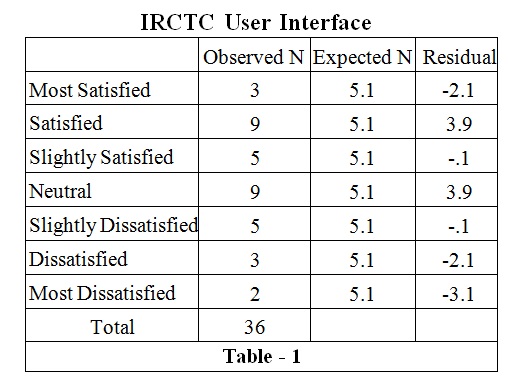
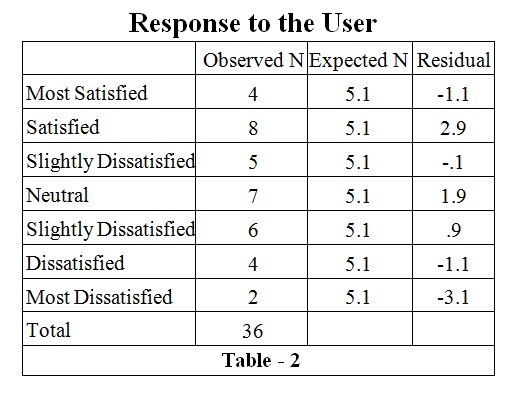
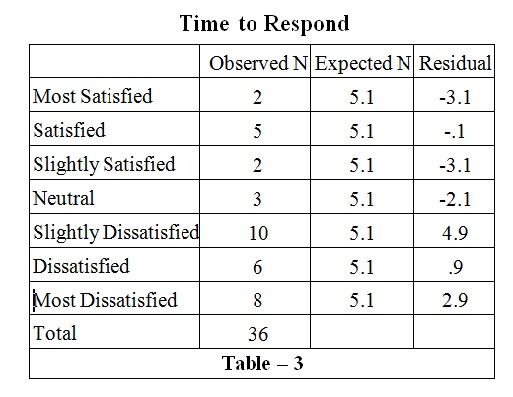
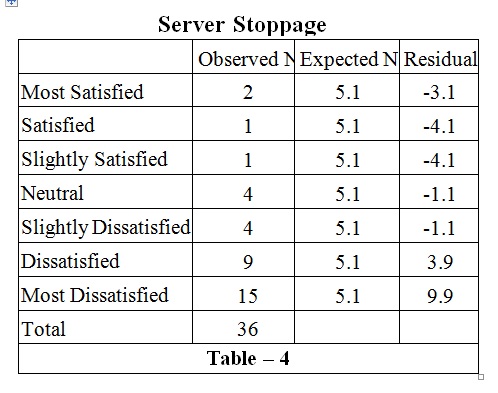

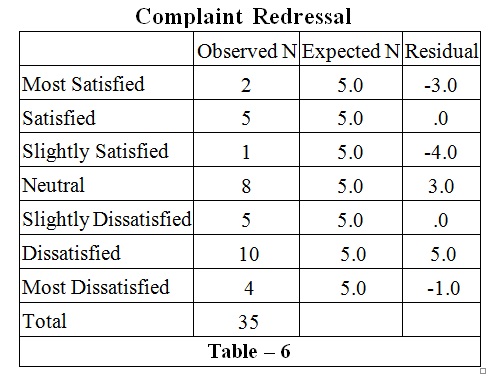
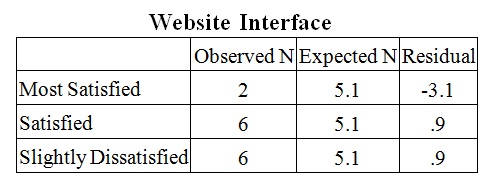
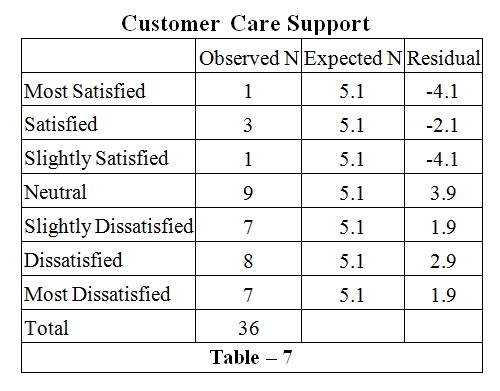
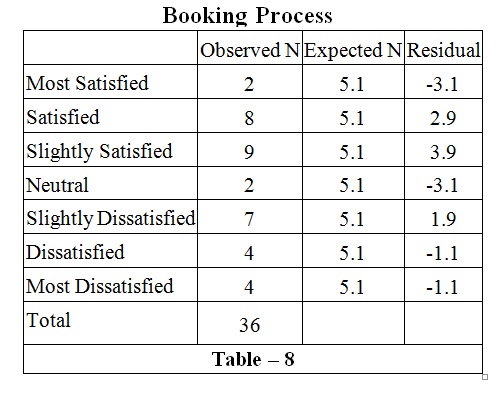
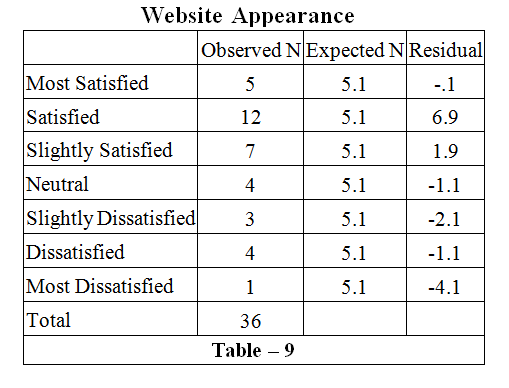
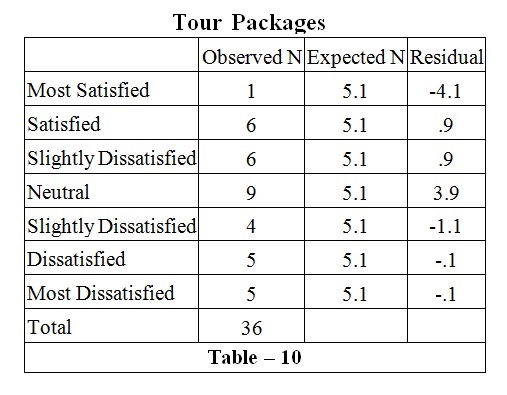
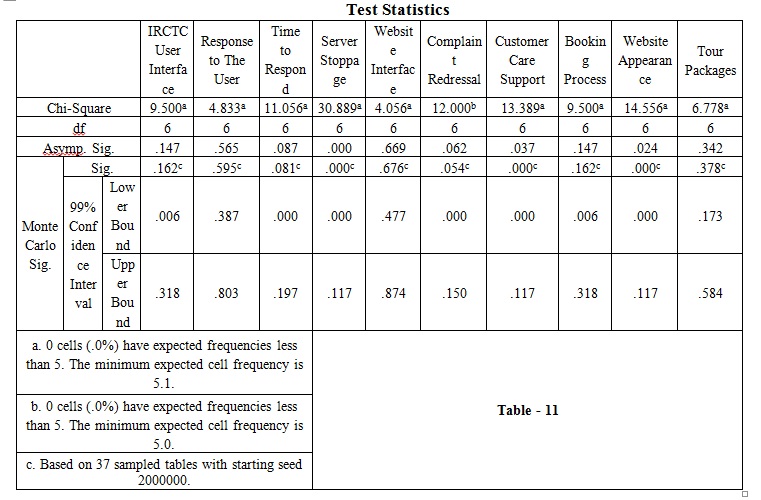
Here, Value of Chi-Square is > 1 in all the tables above.
Hence, H0 is rejected and H1 is accepted.
REFERENCES :
***************************************************
Harsh K. Pandya
MBA (Marketing-International Business)
UGC-NET (Management)
Programme Officer, KCG
Email: harsh.pandya19@gmail.com
Mob: 8469955155



Home | Archive | Advisory Committee | Contact us